Hannover Fair 2013 exclusive show report

The theme of the 2013 Hannover Fair – the industrial mega-show held annually in northern Germany – was the "Fourth Industrial Revolution". The 2013 show included the biennial MDA (Motion, Drive and Automation) event. In this exclusive report, we look at some of the highlights of the Fair.
Visitors to this year’s Hannover Fair could not avoid references to Industry 4.0. This is an initiative, led by the German government, to promote manufacturing on the basis that it is entering the fourth significant phase in its evolution.
First there was the original industrial revolution during the 18th century, triggered by the invention of the steam engine and the mechanisation of manual work. This was followed in the early 20th century by the introduction of mass production and, in recent decades, by the use of electronic and computer technologies such as PLCs to automate manufacturing.
This fourth revolution is based on “cyber-physical systems”, using technologies such as software, communications, and advanced sensors to deliver the truly “smart” factory. Germany’s National Academy of Science and Engineering believes that the new manufacturing processes will lead to a 30% increase in industrial productivity. The German Government is sufficiently convinced to be investing around €200m to help trade bodies, research institutes and industrial companies to develop an implementation strategy for Industry 4.0.
In his end-of-show speech, Dr Jochen Köckler, a board member at the organiser Deutsche Messe, picked up on this theme. “Over the past several days, the world’s leading trade fair for industrial technology has underscored its role as a key driver of the fourth industrial revolution,” he said, “highlighting a sweeping trend towards cross-industry networking and integration.
“The experts all agree,” he added, “that integrated approaches to manufacturing are going to have a sweeping impact on global industry over the next 10 to 15 years, and beyond.”
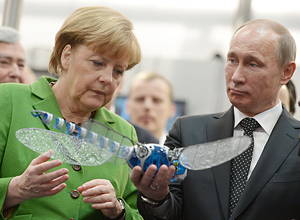
This year’s Fair was opened by the German Chancellor Angela Merkel and the Russian President Vladimir Putin (shown above with Festo's BionicOpter "mechatronic dragonfly"). The show attracted 6,550 exhibitors from 62 countries and the organisers are hailing it as the strongest Fair in a decade, which consolidated its position as the world’s leading showcase for industrial technology.
There were 225,000 visitors – a similar number to the last comparable show, in 2011 – with a quarter of them hailing from outside Germany. About half of the non-German visitors were from elsewhere in Europe and 20% from South, East and Central Asia.
In terms of innovative technologies, 2013 was not a standout year, possibly reflecting cutbacks in r&d budgets during the recession. But there were still plenty of developments to catch the visitor’s eye across the vast showground. Here, we report on some of them.
MOTORS AND DRIVES
ABB may not have had any of the show-stopping technologies that it sometimes unveils at Hannover, but there were several enhancements to its ACS880 drives family as well as a new high-voltage two-pole induction motor for pumps and compressors up to 13.5MW. This rugged, low-maintenance motor was developed in response to customer requests. It has a new rotor bar construction designed to withstand stresses during start-up and running. The motor can operate from 6–13.8kV supplies and is initially aimed at fixed-speed applications up to 3,000 rpm with direct-on-line connections. VSD operation is possible.
The Austrian motor-maker ATB, owned by China’s Woolong Holdings, announced a range of IE4 asynchronous cast-iron motors. The FS 280-355 Super Premium series cover ratings from 90–315kW, and are available in two- and four-pole versions.
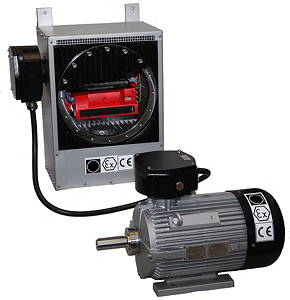
ATB is also developing a package (shown above) consisting of an explosion-proof IE3 motor and an inverter housed in a flameproof enclosure. This package, targeting the chemical industry, will cover ratings from 0.75–11kW and will reduce energy consumption by 50–80%, according to ATB. A prototype is currently being built and will be tested independently. The package is expected to reach the market in early 2014.
Baumüller has been busy extending its range of motors. At Hannover, it was showing a new range of servomotors with nominal speeds up to 6,000 rpm and torque ratings up to 140Nm. These DSP motors have the same external design as the company’s DSC synchronous motors and DSD servomotors, with identical mechanical and electrical interfaces, and the same cooling choices – uncooled, air-cooled or water-cooled.
Baumüller also had a new range of high-torque motors (called DST2) with integrated thrust bearings and top speeds of 600 rpm. In addition, the company has extended its DS range of synchronous motors, giving them about 10% more nominal power, thus allowing machine-builders to save space. The DS2 motors, available in air- or water-cooled versions in ratings up to 300kW, have a top speed of 4,300 rpm.
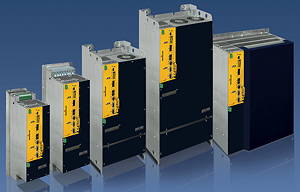
Baumüller has also extended its b maXX 5000 range of converters (above) for power ratings up to 315kW, offering individual power supplies and up to three plug-in safety modules, allowing users to choose which safety functions they want (including SLS or SLP). The converters, suitable for single-axis applications, have integrated rectifiers and DC link capacitors, and offer a choice of five cooling systems. At present they support EtherCat and Varan, with Profinet IRT and Powerlink due to be added soon.
Italy’s Bonfiglioli group used Hannover to unveil a new range of permanent magnet AC synchronous motors offering six levels of torque from 1.7–37Nm. The BMD brushless motors use a salient-pole technology for low inertia and high torque, while rare-earth magnets help to deliver high accelerations and to withstand high overloads without the risk of demagnetisation. Options include flywheel masses, various forms of feedback and holding brakes.
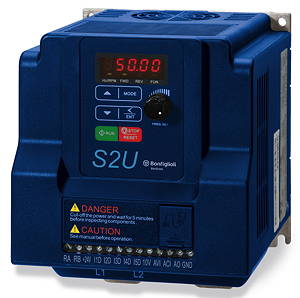
Bonfiglioli also had a new family of compact, plug-and-play inverters that come in two sizes for controlling motors from 0.2–2.2kW. The S2U inverters (above), powered from 230V single-phase supplies, include Modbus ports and can interface with external gateways using most common communications protocols.
Control Techniques was showing how the open Ethernet capabilities of its new Unidrive M generation of drives can deliver high synchronisation accuracies. In a demonstration on its stand, a drive was controlling the synchronisation between two Unimotor HD servomotors monitored by an IP network camera, with all of the components linked via an open IEEE 1588 Ethernet network.
The Taiwanese automation supplier Delta Electronics used Hannover to launch a series of servodrives with a 100Mbps EtherCat capability. The Asda A2-E drives are aimed at demanding multi-axis motion control applications and offer functions such as vibration suppression, closed-loop control, 20-bit encoder and absolute encoder inputs, Safe Torque Off and torque limiting.
New from Eaton is an IP66 version of its recently-launched PowerXL drives, in ratings up to 7.5kW. The drives can be mounted next to a motor or machine, even in harsh environments. The short motor cable lengths makes EMC compliance easier, while the drives’ ability to work outside cabinets simplifies the retrofitting of older installations where cabinet space is limited.
Maxon motor has produced a larger, more powerful version of its EC 22HD heavy-duty motor designed for environments subject to extreme temperatures (above 200°C), high pressures (up to 1,700 bar), large vibrations or high vacuums. The electronically commutated, four-pole 32 HD motor can, for example, be used for downhole drilling and can operate in air or in hydraulic oil. The 32mm-diameter motors have a power rating of 220W in air or 480W in oil.
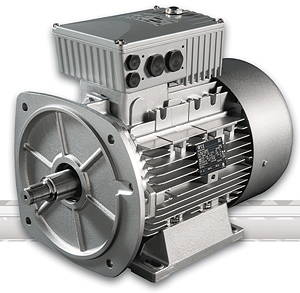
New from Nord Drivesystems is a decentralised frequency inverter designed to be mounted on an asynchronous motor. The SK 180E (above) focuses on speed control and efficiency, dispensing with non-essential functions such as positioning, encoder feedback and sophisticated safety functions. The inverter, for use with motors from 0.25–2.2kW, is said to cut energy use by up to 30% in fan and pump applications by automatic magnetisation adjustment under partial loads.
Other new arrivals on the Nord stand included a range of IE4 motors and as well as the company’s first family of smooth-bodied motors, covering ratings from 0.37–3.2kW.
Another company demonstrating IE4 motors was Regal, whose Symax IHP range of permanent magnet AC machines promise high torque, high efficiency and increased power densities compared to standard induction motors, which they can replace on a drop-in basis. The IP55 motors have a patented insulation system which combines corona-resistant magnet wire with a low-stress winding configuration, in enhance the motor life.
Schneider Electric announced a servodrive with a 130A peak current capability for high-performance servomotor applications. The LXM 62 DC130A drive extends the LXM 62 range of multi-axis servodrives for the PacDrive automation system with a version for continuous currents up to 50A. Used with asynchronous motors, the drives can be linked to diagnostic systems via sercos III. The drive’s power density is said to be one of the highest in its class.
SEW-Eurodrive has developed a frequency inverter, with optional IP66 protection, especially for open-loop control of asynchronous motors in materials-handling applications. The Movitrac LTE-B inverters come in three sizes from 0.37–7.5kW and are factory-set for compatibility with SEW’s gearmotors, cutting start-ups to a few seconds.
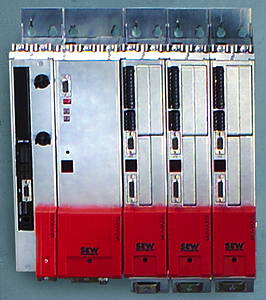
SEW has also expanded its Moviaxis multi-axis servo inverter system (above) by adding a regenerative power supply module for recovering braking energy and feeding “blocks” of current back into the supply system. The MXR81 module thus offers an alternative to the existing MXR80 regenerative power supply which feeds sinusoidal current back into the supply.
SEW-Eurodrive has also extended some of its motors ranges, including the CMP series of servomotors, which has a new model that extends peak torque levels to 320Nm. The compact CMP112 motor can be mounted on modular gearboxes and has a low-inertia rotor that allows it to achieve high angular acceleration rates and short cycle times.
SEW’s DR modular motor system has also been extended by the addition of higher-power sizes (250/280) offering a choice of IE1, IE2 or IE3 efficiencies. The motors, which have shorter bodies than previous models, are available by themselves or as gearmotors.
Another company expanding its motor ranges is Siemens. For example, it has launched a second generation of its Simotics HV H-Compact motors for LV and MV applications. The high-output, low-noise machines have power densities that are 5% higher and efficiencies that have been raised by 0.4% to 96.5%. They cover power ratings from 900–4,000kW and can be ordered as explosion-proof versions operating from 690V–11kV.
Siemens has also produced a range of explosion-proof LV motors based on its 1LE10 series. The new 1MB10 machines are available in IE1, IE2 and IE3 versions and in Ex t or Ex nA protection for use in Zones 21/22 and 2. They cover ratings from 0.75–18.5kW in shaft heights from 100-160.
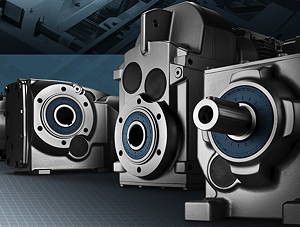
An expansion of Siemens’ Simogear geared motors family (above) takes torque ratings up to 5kNm and power ratings up to 30kW. The motors are available in IE2 or IE3 versions with low-backlash versions available as an option. The gearboxes are now Atex-certified for use in zones 1, 2, 21 and 22.
WEG has extended its range of roller table motors for the steel industry so that the biggest size has been increased from IEC 200 to IEC 400. The low-maintenance machines, available with four to 12 poles, can deliver up to 2.972kNm of torque.
CONTROLS
For the first time, Beckhoff is offering users the option of displaying status messages or diagnostic information on a module that integrates directly into its EtherCat I/O system. The DIN-rail-mounting EL6090 EtherCat display terminal (shown below) has a two-line illuminated LCD and a non-resettable hours counter. It reduces installation and parameterisation efforts. The lines scroll automatically if the 16-character limit is exceeded.
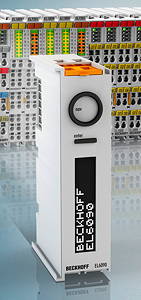
B&R Automation has increased the temperature ranges of its IP20-protected X20 and IP67-protected X67 I/O modules. The modules will now operate in temperatures from –25 to +60°°C and can be stored at temperatures from –40 to +85°C.
Eaton has developed an Android phone and tablet app for its easy800 control relays that allows users to monitor and operate the relays remotely over a distance of up to 10m using Bluetooth communications. The easyRemote app can be used to change function block parameters, display text, change operating modes, set dates and times, and to check circuit diagrams. It allows users to avoid noisy or dangerous environments.
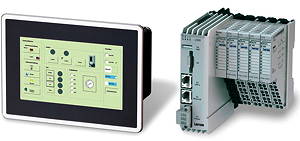
Lenze has launched two ranges of PC-based controllers for simple motion and sequence control tasks (shown above). The c300 cabinet controller, which comes with built-in EtherCat and CanOpen interfaces, is claimed to be the most compact small controller in its class to offer motion control functions. It can be connected in series with I/O modules from Lenze’s I/O system 1000. The second arrival is the p300 panel controller targeting low-to-medium complexity control and visualisation tasks. It aimed, in particular at harsh environments, and offers a choice of touchscreen displays from 10.9–26.4cm. Extension modules to support Profibus and Profinet are planned.
A compact digital positioning controller from maxon motor offers real-time positioning of synchronised multi-axis systems. The compact EPOS3 70/10 EtherCat controller can control DC and electronically commutated motors up to 700W. It operates from 11–70V DC supplies and can deliver a continuous current of 10A, and up to 25A during acceleration and deceleration.
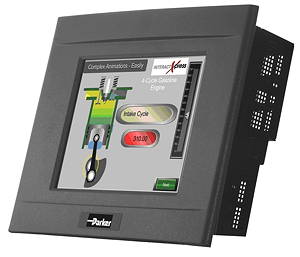
Parker Hannifin used Hannover to announce an affordable touchscreen HMI system covering screen sizes from 6–15 inches. The XPR2 HMIs (above) are supported by software that makes it easy to implement touchscreen applications, offering prebuilt templates for common functions such as alarm management. The software supports unlimited tags and includes more than 40 device communications drivers. There is also runtime software that allows users to view and edit HMI applications from any location.
A flurry of controls announcements from Siemens included a new high-end controller for its modular S7-1200 series. The S7-1217C CPU has 25kB more work memory than previous models and comes with ports to drive stepper motor controls at up to 1MHz. It has a processing speed of 0.08µs/operation.
New firmware (v 4.0) for all S7-1200 CPUs enables them to operate as Profinet iDevices, provides a real-time tracing function for diagnostics and debugging, implements formula and recipe management in the CPU, and offers enhanced access protection against unauthorised configuration modifications.
Siemens has also announced a pair of Simotion TMC (terminal module compact) modules for high-performance motion control applications. The TMC1080PN (with front terminals) and TMC1180 PN (with ribbon cable plug-in connectors) allow fast, precise I/O to be connected to motion controllers using high-speed Profinet IRT (isochronous real-time). The 75mm-wide modules support 80 channels with digital I/O being combined in groups of eight with low signal delays.
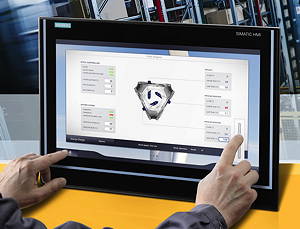
Siemens has also launched its first industrial monitor that uses projected capacitive touchscreen technology and supports gesture and multi-touch operation (with up to five simultaneous touch-points). The 19-inch IFP1900 MT monitor (above) has a scratch-proof, chemical-resistant glass front, and can detect spurious touches and operator actions. It can be operated using thin gloves, while the multi-touch facility allows panning, zooming and other manipulations of the display.
Wago has introduced a lower-cost version of its Telecontroller for smaller installations. The Eco Telecontroller is limited to a maximum of four modules from Wago’s I/O-system 750, reducing its cost by more than a third. The Codesys-programmable controller has a built-in Web server that supports remote configuration and diagnostics via the Internet or an intranet.
ELECTRICAL AND SAFETY
Eaton has added a pair of circuit-breakers with integrated monitoring functions to its xEffect series. The NZM3 and NZM4 breakers can measure and transmit phase-related current and voltage values with corresponding power and energy values. No accessories or extra wiring are needed for current transformers or voltage tap-offs, simplifying switchboard assembly. The data gathered can be viewed via small built-in displays or using a self-configuring visualisation system (called BreakerVisu) that can show data from up to 48 breakers on a colour display.
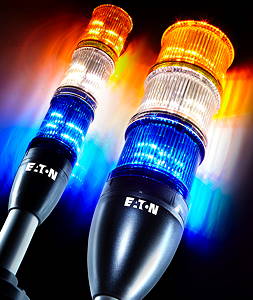
Eaton has also launched a modular signal tower system in two sizes (shown above) with a quick-assembly bayonet fitting design said to cut assembly times by up to half. The standard SL7, and the space-saving 40mm-diameter SL4 variant, allow up to five modules to be combined. These include bright LED modules in six colours, and acoustic modules with eight different tone signals for different faults and adjustable volume settings up to 100dB.
Igus has given its micro energy chains a makeover to make them sturdier and quieter than their predecessors. The E2 micro chains can handle loads up to 100% heavier and offer a maximum self-supported length of 1.25m – 25% longer than before. Initially they are available with inner widths of 20mm (and heights of 10mm or 15mm), and seven further widths are planned.
Another energy chain supplier, Kabelschlepp Metool, was showing a system for protecting its Robotrax cable carriers from premature wear. These carriers, designed for use on robot arms, can wear as a result of repeatedly touching the arm. The Protector is designed to prevent this from happening.
New from Kübler is an IP64-protected slip-ring that handles up to three load (power) and two signal transmissions between stationary and rotating platforms. The 60mm-diameter SR060 slip-ring has a service life of more than 500 million revolutions and can operate at up to 500 rpm. Its design prevents particles form escaping, thus making it suitable for clean applications.
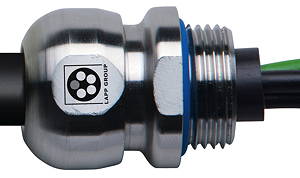
The Lapp group has developed a stainless-steel cable gland with a rounded design with few corners or edges, minimising the accumulation of dust, dirt or food residue. The shape and material of the Skintop Inox gland (above) make it particularly attractive for food and pharmaceutical applications.
New from Nord is a motor-mounting distributed starter that provides soft-start and reversing functions for motors from 0.25–7.5kW. The SK 135E starter provides overload protection via thermistor monitoring, mains and motor phase failure monitoring, I2t monitoring and magnetising current monitoring. Instead of circuit-breakers, reversing contactors and brake rectifiers, it uses wear-free electronic switching.
Phoenix Contact has a new family of industrial relays ranging from 6.2mm-wide coupling relays to contactor replacements. The Rifline relays use the company’s push-in connection technology to save installation time and can use bridging materials from its existing terminal blocks for simple current distribution. Some of the relays can be upgraded to timers using plug-in modules.
Pilz has added two new functions for implementing applications with position-based safety functions to its PMCprotego S drive safety cards – SLP (safely limited position) and SLI (safely limited increment). SLP monitors end limits, while SLI limits transport steps when materials are fed into a process. The SLI function can be used with SLS (safely limited speed) to allow axes to be operated in a safe jog mode.
Pilz has also announced a series of new accessories for its PSENopt light grids, including post protectors, deviating mirrors and housings that provide protection up to IP69K, allowing the equipment to be used in environments subject to condensation or high humidity.
Rittal has developed a new generation of its TopTherm enclosure chillers in seven sizes with outputs from 8–40kW. The chillers are now housed in 600mm-deep enclosures instead of the previous 800mm. By placing the condenser fan on the enclosure roof, heat can now be dissipated to the outside, while internal heat loads can be avoided. New controller logic reduces on-off switching cycles of the main components, increasing energy efficiency. New options include 24V DC control voltages and water-cooled condensers.

Rittal has also announced a new housing for operator panels, made of sheet steel and aimed at the cost-sensitive machine-building market. There are nine standard sizes and the enclosure (above) is based on Rittal’s AE system. One-person assembly is possible.
At Hannover, Siemens announced several safety developments including: the integration of its Step 7 Safety engineering software into its TIA Portal V12 engineering framework; a range of failsafe I/O modules for its distributed ET 200SP I/Os; and new failsafe Simatic S7-1500F controllers based on the standard models but expanded with safety functions certified to EN 61508 and suitable for applications to SIL 3 / PL e.
Siemens has also developed a 24V DC UPS (uninterruptible power supply) with an Ethernet interface that can be integrated into an Ethernet network or, via Profinet, into a TIA environment. The Sitop UPS1600, available with output currents of 10A or 20A, can protect multiple controllers or industrial PCs (IPCs). If needed, it can deliver up to three times the nominal current to start up IPCs.
Siemens has developed what it claims is the smallest vacuum circuit-breaker for air-insulated MV switchboards up to 12kV. The Sion 3AE5 breaker is 30% smaller than its predecessor, resulting in smaller, less costly switchboards. It measures 540 x 447 x 390mm.
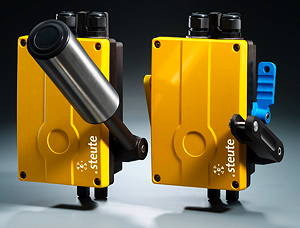
New from steute is a series of switchgear products for demanding environments. The 91 series heavy-duty products (shown above) include: emergency pull-wire switches with fibreglass-reinforced thermoplastic enclosures and stainless-steel screws; a belt-alignment switch with an adjustable roller that monitors the correct performance of conveyor belts; and heavy-duty position switches for use on machines in demanding industries.
Weidmüller is offering a range of single-phase solid-state relays for reliable, noise-free switching of AC loads up to 75A. Using an optional plug-in controller, the PSSR relays can also be used to monitor current on five loads connected in parallel and to set off an alarm if the current drops by 16%. It can also identify and report short circuits and disconnections, and detect defective loads.
MECHANICAL AND LINEAR
The American robot-maker Adept Technology announced at Hannover that it is extending its range of PLC-programmable robots with new ePLC versions of its Cobra Scara robots, Quattro four-arm delta robots, and Viper articulated robots for assembly applications. The ePLC versions interface directly with PLCs from Rockwell and Siemens, making it easier and quicker to deploy robots without having to learn a new programming language.
Bauer Gear Motor used the Hannover Fair to launch a business called Industrial Drive Applications that will design and build helical and helical-bevel gearboxes in torque ratings up to 300kNm, and planetary boxes up to 1.5MNm.
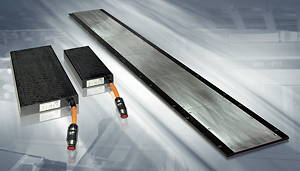
Baumüller announced a new range of long-stroke asynchronous linear motors in three sizes with nominal force ratings up to 600N and capable of speeds up to 5ms. The water-cooled LAE10 motors (above) can be used with a linear encoder and servo controller for precise programmable positioning. They can also be used with frequency converters to operate in a speed control mode.
Bibby Transmissions (part of Altra Industrial Motion) has expanded its Torsiflex range of disc couplings and made design improvements which allow smaller couplings to be used. It has introduced a new, easy-to-maintain hub that can accommodate large-diameter shafts, thus reducing coupling sizes and weights.
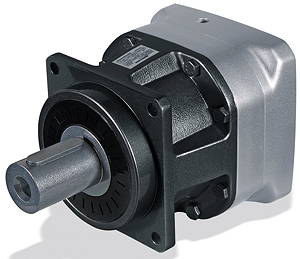
Bonfiglioli has worked with a “famous design studio” to develop two ranges of low-backlash planetary gearboxes in five sizes with output torques from 30–800Nm. The low-maintenance TQ in-line (above) and TQK right-angle boxes use a special tooth technology that is said to result in high safety factors for transmissable torque and the ability to withstand high overhung and thrust loads. The IP65-protected boxes also exhibit high torsional rigidity and low noise.
Festo says that its EXCM H-gantry will allow fast and precise positioning in cramped locations. The compact planar surface gantry uses a recirculating toothed belt to move a slide on two axes to reach any point in its working area. The ready-to-install system can achieve speeds of 500m/s and repetition accuracies of ±0.05m.
The Swiss company Güdel has a new generation of linear axes that use large rollers to provide rigidity and stiffness. The dirt-resistant Trackmotion TMF axes are manufactured in sections that can be combined to achieve stroke lengths of up to 100m. They can be driven by servo gearboxes or dynamic planetary gearboxes.
Maxon motor has added two single-stage planetary gearheads for high radial loads to its GP32 range. The bearings have been repositioned and the planetary carrier reinforced to handle radial forces up to 140N in applications such as toothed belt drives. As an option, ceramic axles are available to achieve short-term torque ratings up to 1.25Nm.
Nexen was demonstrating a new harmonic gearhead designed to replace planetary gearheads, and said to require less than half the space of alternative technologies. The patent-pending strain wave gearing technology delivers a rigid, high-torque, zero-backlash system.
Parker Hannifin announced a 45mm-wide screw-driven linear positioner that can position loads of up to 7kg with a repeatability of up to ±1µm and an accuracy of 6µm (depending on the encoder used). The MX45S positioner is available in travel lengths of 5, 15 or 25mm and can be supplied with high-efficiency leadscrews or high-precision ballscrews. Both can produce up to 40N of thrust at linear velocities of 20mm/s and 30mm/s respectively.
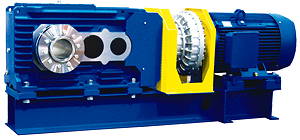
Rossi presented a new series of gear reducers targeting applications such as conveyor belts in the mining sector. The G series reducers (above) have longitudinal finned housings with forced ventilation to lower the operating temperature and to allow increased power at constant operating temperatures. They are interchangeable, in terms of dimensions and spares, with Rossi’s existing helical and bevel-helical G05 products.
Schaeffler has developed a sealed spherical roller bearing which cuts grease consumption by up to 80% and has the same outer dimensions as non-sealed versions, thus providing an almost maintenance-free alternative that is also protected against contamination. The FAG E1 X-life bearing has an innovative seal that minimises the loss of grease and avoids the need for relubrication systems, while maintaining high dynamic and static load ratings.
Schaeffler has also expanded its range of large, long-life tapered and cylindrical roller bearings. Its two- and four-row tapered bearings with outer diameters of 320–625mm and its cylindrical roller bearings with diameters of 320–1,600mm will, in future, be available as X-life products with load ratings that are about 20% higher. This can be used to improved performance, reduce weights, or apply higher loads while maintaining the same rated lives.
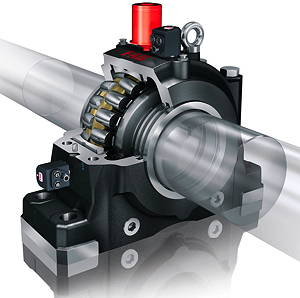
Another Schaeffler innovation is a new plummer block housing which, it claims, will extend the operating lives of fitted spherical roller bearings by up to 50% compared to conventional housings. The FAG SNS housing (above), which can replace many existing housings directly, ensures optimum load distribution in the bearing. Further design optimisations make it easy to mount/dismount and improve conditioning monitoring.
SEW-Eurodrive has added a pair of low-loss two-stage helical-bevel gearboxes to the lower end of its power range. The compact K19 and K29 boxes offer efficiencies of more than 90% for all ratios, allowing smaller motors to be used in some applications. They have hypoid gearing in three different ratios in the output stage, and offer total ratios from 3–70.
SEW has also introduced two new planetary gear systems, extending its upper torque capacity to 500kNm. The arrival of the P092 and P102 boxes means that SEW now offers industrial planetary gears in 11 sizes covering a torque range from 24–500kNm. If required, the short gearboxes can be used with helical and helical-bevel designs in various combinations.
Siemens has developed a new generation of high-performance steel couplings offering increased axial offsets and larger bore capacities than previous versions. The Arpex couplings are also lighter, yet have a higher torque capacity. Component geometries have been improved, resulting in an optimised centre of gravity.
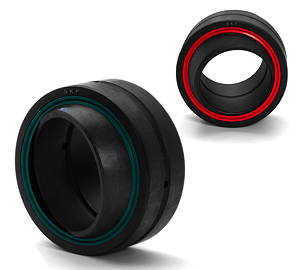
At Hannover, SKF unveiled a new range of long-life spherical plain bearings and rod ends (above) that need no lubrication and fill the gap between standard steel/steel plain bearings and maintenance-free TX plain bearings. The Extended Life bearings have heavy-duty triple-lip seals that almost eliminate the ingress of contaminants that could lead to premature bearing failures. A 100mm-bore bearing can save up to 876kg of grease per year.
FLUID POWER
Atlas Copco has announced a lubricated screw compressor with a single-stage design that is said to improve performance by up to 10% compared to the previous generation. The GA250 compressor also has a 5% smaller footprint, while an energy recovery system allows heat generated by the compressor to be recovered and used elsewhere on a site.
Bosch Rexroth was demonstrating new control electronics for its latest generation of pneumatic valves (AV03) that it launched at Hannover in 2012. The AES electronics connects the valves to industrial controllers, via fieldbus or Ethernet. There are also new online tools for configuring the company’s pneumatic components, including a program that predicts future air consumption at the design stage.
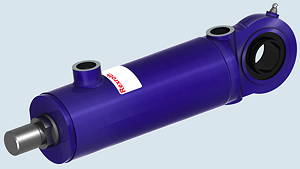
Rexroth has also announced a mill-type hydraulic cylinder (above) designed and tested for two million load cycles. This will allow engineers to calculate the CDL2 cylinder’s lifecycle for an application, as well as its price performance ratio. The cylinders, for operating pressures of 160 and 250 bar, offer four mounting types and strokes of up to 3m.
SENSORS AND MEASUREMENT
At Hannover, Balluff was demonstrating fork and angle through-beam photo-sensors (shown below) that cobine the transmitter and receiver in one housing, making them easy to align, connect and commission. The sensors need just one cable connection. The fork sensors vary in width from 5–220mm while the right-angle devices have side lengths from 40–110-mm. They include red-light, infrared and laser models.
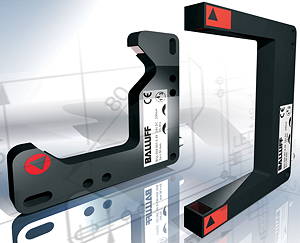
Brüekl & Kjaer Vibro launched a new generation of eddy-current displacement sensor systems for monitoring vibrations in machinery. The Series ds821 (and an Atex version, called ds822) use a driver (oscillator/demodulator) that determines the length of the connected cable (up to 10m) automatically and adapts measurements accordingly. Previously, the choice of the driver depended on the length of the cable. The new system, with measurement ranges of 2 and 4mm, is more flexible and reduces spare parts counts.
Bender has announced a new insulation fault locator that, it says, will simplify fault location and mobile residual current measurement. The EDS195P (shown below) can be used on AC/DC control circuits from 24–230V as well as main circuits from 24–960V. Bender has also launched a condition monitor with a built-in 7-inch touchscreen for measuring current and voltage quality. The CP700 monitor communicates with Bender monitoring devices and present the information in a clear manner, generating alarms if required.
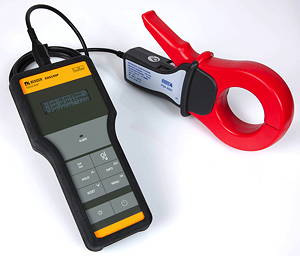
Kübler has several new ranges of encoders including absolute EtherCat encoders claimed to have the shortest bus cycle on the market. The Sendix encoders provide position updates within 62.5µs, allowing users to implement dynamic systems. They can calculate speeds internally, avoiding the need to use a controller for this.
Kübler also has two new two new 58mm-diameter CANopen optical encoders (Sendix F5868/5888) with 15mm hollow-shafts and a function that prevents errors at the end of the encoder’s physical resolution when a scaling factor is active. There is also a range of SIL2 incremental and absolute encoders that rounds off the bottom end of Kübler’s certified SIL encoders. Finally, Kübler was showing an optical fibre version of its Sendix H120 heavy-duty encoder, allowing routing of signals through electrically noisy environments.
Pepperl+Fuchs has three new families of ultrasonic sensors. The UB…F77 series packs a transmitter, receiver, transducer, indicator and a connector into a sealed enclosure the size of two sugar cubes. The UC…30GM70 series has an adjustable switching distance and a high-speed bidirectional infrared interface that adapts it to an application. The UC…30GM-IO series allows parameters to be adjusted via IO-Link without using external tools. The switching distance to be adjusted at the touch of a button.
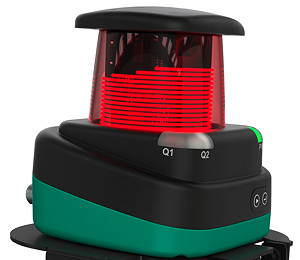
P+F also has a compact 2D laser scanner with a 50Hz scanning rate that can perform 250,000 measurements per second – resulting in high precision and the ability to detect tiny objects or precise edges, regardless of ambient conditions, surface finishes or colours, or extraneous light sources. The R2000 scanner (above) uses 24 LEDs to create a cylindrical display of text and graphics that can be seen all around the device. The display also offers a “spirit level” function for aligning the scanner easily and quickly.
Siemens has expanded its Siplus CMS2000 condition monitoring system by adding a module that allows eight piezo-electric vibration sensors to be connected to the system to provide more comprehensive monitoring and to cut costs per channel. Two of the Vib-Mux (vibration multiplexer) modules can be used simultaneously to provide 16 sensor connections. The system, designed for permanent installation, also records speed, temperature and other variables for predictive maintenance.
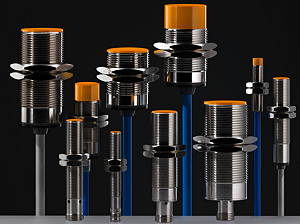
At Hannover, steute introduced a family of inductive proximity switches (above) as an alternative to electromechanical position switches or magnetic sensors. The three-wire DC sensors, which have long switching distances, have PNP switch inserts with one NO contact. There is a choice of sizes from M8 to M30, and plug-in connectors or hard-wired cables. Protection is from IP67 to IP69K. There are special versions for extreme temperatures and for hazardous areas (zone 0 and 20).
Weidmüller has launched a device that measures and records electrical characteristics such as current, voltage, and apparent and reactive power for each connected phase as well as in total. The Power Monitor (below) has a four-line backlit display that is updated every 0.1s and is accurate to within 1%. The monitor can record currents down to 1mA for standby measurements. It can be integrated into higher-level power management systems and has built in USB and RS-485 ports.
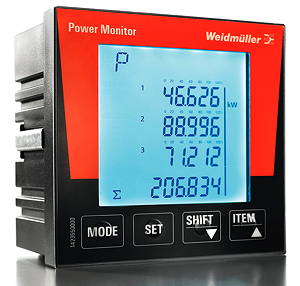
Weidmüller also has a new device that registers, records and timestamps large current pulses such as those produced by voltage surges or lightning strikes. The Varitector Logger 30 can be used to document system loads. It uses an external sensor with a ferrite toroid and has a built-in two-line LCD for visualising pulse data.
COMMUNICATIONS
Beckhoff was celebrating EtherCat’s tenth anniversary at Hannover. Its latest EtherCat product is a compact box (shown below) with eight selectable digital inputs or outputs, two digital tachometer inputs with a 2.5kHz limit frequency, two analogue inputs, one analogue output and a current-controlled 1.2A PWMi output that can be used, for example, to control simple proportional valves. The IP67-protected EP8309 EtherCat Box is said to simplify wiring when controlling EtherCat equipment outside of protective cabinets. The tachometer inputs can be used to monitor two speeds on two different shafts or, with simple sensors, the speed and direction of rotation on one shaft.
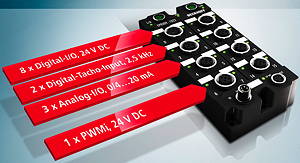
New from Lapp is a Profibus optical link module which, it says, is a cost-effective, high-performance alternative to standard optical signal converters. The Epic module can be used as a bus extension in Profibus networks, or in environments where EMC is a factor. Diagnostic LEDs help with troubleshooting.
Lapp also has “the world’s first” ultra-flexible, torsion-resistant Ethernet cables that can transfer data at speeds of up to 10Gbit/s. The Etherline Cat 6A cables are aimed at applications such as robotics and machine vision systems. There are two versions: one for use in energy chains requiring at least a million bending cycles; the other for high-torsion applications. Lapp had to develop a new construction to screen both individual twisted pairs and the whole cable, that would be sufficiently hard-wearing in constantly moving cables.
Phoenix Contact has announced a Bluetooth wireless module that can transfer Ethernet data over a distance of up to 250m at up to 3Mb/s. The IP65-protected FL BT EPA MP module is compatible with Profinet, ProfiSafe, Ethernet/IP and Modbus TCP. It can handle up seven Bluetooth connections in parallel. Its 1.1W power requirement makes it suitable for battery-powered applications.
Siemens has released a new version (v12) of its Sinema Server network management software designed to monitor Ethernet and Profinet networks continuously. The new version can monitor 500 devices – twice as many as before – and can display the status of up to 100 other Sinema Servers in a network. Connected components are identified automatically. The software, allows users to define alarm thresholds for various parameters. It can also be used to document device inventories and network availability and utilisation.
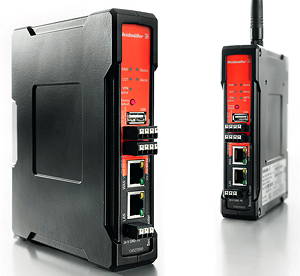
Weidmüller unveiled an industrial router (above) that provides secure communications between Ethernet-based systems and higher-level networks via a pair of Gigabit Ethernet ports. The Gigabit Security Router has a built-in firewall and other security functions. It can prioritise and channel network traffic and map IP addresses. Built-in VPN remote maintenance functions provide secure remote access to components and systems on a network.
Weidmüller also has a new surge protection device for Ethernet applications. The Varitector Data Cat 6 device protects Ethernet and Power-over-Ethernet networks against damage from voltage surges or lightning strikes. It provides protection for four pairs of wires up to 250MHz and, if needed, can also be used for Cat 5 installations (up to 100MHz).
SOFTWARE
ABB’s Automation Builder engineering suite can be used to program, configure and monitor drives, PLCs, HMIs and other devices. The software, aimed at machine-builders and systems integrators, can be used to customise the firmware in ABB’s ACS880 drives. It is based on the Codesys programming environment. All project data and control code can be stored in a single archive.
On its stand, Baumüller was demonstrating a new “co-ordinated motion” component library that allows robot and CNC functions to be used in its Motion Control SPS software. This is said to make it easier for users to achieve co-ordinated movements on several axes. The software supports the IEC 61131-3 languages and path movements are programmed using G code. A CNC program can be loaded into the software as a simple text file and data from CAD/CAM systems can also be used to program machines.
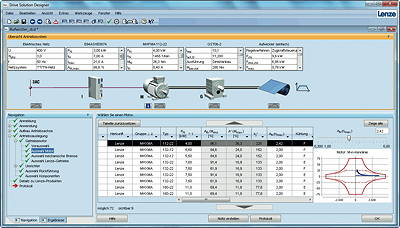
Version 4.0 of Lenze’s Drive Solution Designer software (above) includes functions to simplify the dimensioning of winding drives, as well as an “application tuner” that allows further possible operating states and material recipes to be integrated into the dimensioning process. The downloadable software, which Windows 8 compatible, also promises improvements in usability and the ability to generate CAD data.
A new version (6.1) of Rittal’s Power Engineering planning software provides support for the new IEC 61439-1/2 switchgear standard. The software guides the user through the planning and configuration of the switchgear one step at a time, and offers assembly instructions, parts lists and other documentation. An “assembly planning assistant” helps installers to operate more efficiently, and all drawings can be exported in standard CAD formats.
The latest version of Siemens’ TIA Portal engineering environment allows users to configure and monitor its Sinamics G120 drives using version 12 of the Sinamics Startdrive software. The drives can be configured in a similar way to a controller or HMI. The software can also be used to integrate Simotics motors into the engineering framework, while safety function views allow the efficient commissioning of safe drive systems. The new version of Startdrive also includes a trace function that can monitor up to eight signals simultaneously for diagnostics purposes.
The next Hannover Fair will take place from 7–11 April, 2014.





